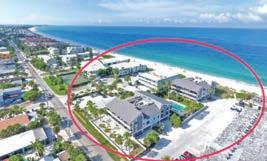22
THE SUN
REAL ESTATE
NOVEMBER 4, 2020
FEMA not the last word on flood risk estimates
W
e’re getting close to the official end of hurricane season and the accompanying flooding that comes with hurricanes. Every homeowner reading this column already knows they live in a flood zone or very close to one. Nevertheless, there is some new technology that is able to provide more flood information for homeowners and potential homeowners. According to First Street Foundation, a non-profit research firm, nearly six million properties across the United States have a substantial risk of flooding that isn’t disclosed by the federal flood maps. The foundation released their own flood maps in June compiled by researchers, modelers and scientists who are advocates for providing homeowners with more information about flooding and climate change. The Federal Emergency Management Agency’s (FEMA) flood maps outline flood zones and have long been used by homeowners and developers to determine which properties have at least a 1% annual risk of flooding. The First Street analysis suggests
Castles in the Sand LOUISE BOLGER that millions of American homeowners could be more vulnerable to flooding than FEMA’s maps indicate. They go on to say their maps show more properties with a 1% flood risk than FEMA because they include parts of the country that FEMA hasn’t mapped and use current climate data and rainfall-related flooding. Their position is their maps do not conflict with FEMA’s, rather they complement one another and give homeowners a more accurate picture. First Street projects that by 2050 the total number of contiguous U.S. properties with a 1% annual flooding risk will increase to 16.2 million, or 11.4% of total properties. Since mortgage lenders require home-
owners to purchase flood insurance based on FEMA’s flood zones, this is important information for the real estate industry. Millions of American homeowners could be more vulnerable to flooding than they realize and may not have the option to purchase flood insurance or have the resources to rebuild in the event of a flood. The former chief executive of the National Flood Insurance Program agrees that FEMA’s maps are a snapshot in time that can change with time. Also, in the past three years, more than 40% of flood claims have been for properties that are not mapped by FEMA or are outside FEMA’s annual risk zones. Although First Street Foundation’s analysis is meant to help homeowners and insurers, not all floodplain experts around the country agree with their research methods and conclusions. Nevertheless, the First Street Foundation’s findings are now a part of realtor.com’s website. Properties listed on realtor.com now display a “Flood Factor” indication providing FEMA’s flood zone for
the property as well as other information regarding flooding. This is the first of its kind flood data on realtor.com and will give home shoppers and existing homeowners easy access to information that previously was not as available about the flood risk of a specific property. There is more information on First Street Foundation’s website, which is helpful to those of us living in existing flood zones, as well as a further explanation of their research. It’s estimated that 23% of all properties have a major to an extreme risk of flooding, and that flooding risk will increase by almost 800,000 properties during the next 30 years, much of it due to new construction along the country’s coasts. We live here and we understand flooding, but there are many areas around the country that border lakes, rivers and creeks that have the potential of flooding. Many of these property owners aren’t aware of the risk until it happens, so any additional information that can be provided to them can only be a good thing. Stay dry and stay safe.




